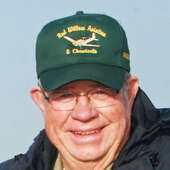- Sweatshirts, Jazzercise, and an unforgiving political climate (11/19/24)
- After the election: Lessons from history (11/5/24)
- Candy or cash: candidates and causes trick-or-treat for donations (10/29/24)
- You are fired! (10/1/24)
- Enduring heritage: Model Tís and Nebraskaís Unicam (9/24/24)
- YMCA project, coming changes and another attack (9/17/24)
- Class of '55 to share memories for Heritage Days (9/10/24)
Opinion
Two legends almost gone
Tuesday, April 8, 2014
Drive north out of McCook about five miles. Look to the West and you can see the bleaching bones of the remaining hangars from the World War II McCook Air Base. In 1944, the base was dynamic, full of life, training crews to fly the then-brand-new B-29.
At the right spot on the then-graveled Hiway 83, one could also see the tops of the tails of those very same B-29s. The U.S. built a total 2,513 B-29s. Seventeen remain now and only one is still flyable.
Last Friday at almost exactly the same time as we looked to spot the remains of that long-gone airbase and to look in vain for the missing elegantly shaped vertical stabilizers and rudders of the long gone B-29s one of the crew members of those very same aircraft breathed his last breath at Community Hospital.
In 1945 LaMoine Keene, one of America's finest, was learning to be a Flight Engineer on that most complicated of aircraft. Four 2,200-hp R-3350 engines each swinging a 16-foot, 7-inch diameter propeller. Each engine was boosted with two turbo-superchargers.
Thirty fuel tanks holding 9,400 gallons of fuel to feed those engines. Extra oil tanks for each, gauges to monitor their health, starter switches, magneto switches, control levers and more gages. Controls to monitor state of the art whole aircraft pressurization system and more.
I once counted 144 switches, gauges and controls on the engineer's panel, all of which that essential crewmember had to know intimately.
All that to be learned by a 23-year-old Lamoine, who had grown up right here in Southwest Nebraska. B-29s, pushing the state of the art, were being lost in fearsome numbers in training accidents as well as on their critical missions bombing a fanatical Japanese homeland.
Yet LaMoine and hundreds of other unsung patriots volunteered to step forth as crewmembers of this most expensive project of World War II and live or die for their country.
In LaMoine's case, the war ended just as he was being signed off as qualified proficient to fly B-29 missions. With the end of the war, all training programs abruptly closed and he and thousands of his peers returned to civilian life. Back home, LaMoine chose to serve as a train crewman, eventually assuming the responsibility of conductor. Already married to his beloved Elaine, together they the raised two accomplished and productive children. So goes the rapidly expiring "Greatest Generation" that won a world war then returned to build and leave us the wonderful community we are privileged to live in today.
Some 15 years after LaMoine departed the B-29, yours truly found myself serving as a crewmember on that same airframe. Well, actually, I was flying the B-29D that had the earlier Wright engines replaced with Pratt and Whitney R-4360s. That 4360 number denotes the number of cubic inches displacement and they each produced 3500 brake horsepower for takeoff. Then the Air Force redesignated it B-50. To haul more cargo and people, Boeing sliced the top off the fuselage, placed a deck across the joint and riveted a much larger tube on top the deck then called it a Stratoliner. In military garb, it became a C-97 or more numerous KC-97 Stratotanker.
Back in about the year 1962, reminiscent of the currently missing Malaysian Flight 370, we were sent out in our tanker to search off the coast of Massachusetts for a missing B-52.
A hundred or so miles out over the Atlantic the B-52 was supposed to have descended from high altitude to low level. The mission was to test the East Coast defenses and see if he could penetrate inland below radar coverage attempting to (electronically) bomb one of the large East Coast cities.
The B-52 crew never returned to base and assumed crashed into the sea. No distress call, no emergency beacon, just simply vanished and never ever heard from again. No black box to help find the wreckage in those days.
We in the tankers were sent out to look for debris, some artifact that could have been left floating after a crash into the water.
It was a new experience for this farm kid from the flatlands of Nebraska. We flew at about 1,000 feet above the ocean surface. Hour after hour in our briefed boxlike search pattern. That day, I learned that the ocean surface is not exactly barren. We encountered long windrows of floating trash, plastic bags, chunks of wood both natural and finished lumber.
Rafts of seaweed and where there was enough accumulated junk one could see sea birds searching for small fish and other marine life attracted to the floating stuff.
I can attest that after 10 or 12 hours of droning along scanning the surface of the ocean one's eyes burn and the body becomes dead tired.
It is a mind-numbing tough job. Sadly to say, neither we nor any of the dozen or so other searching tankers found any debris that could definitely prove that the missing bomber did indeed crash into the ocean. It is still missing and all five crewmembers on board presumed dead. No closure for those families either.
That is the way I saw it.

